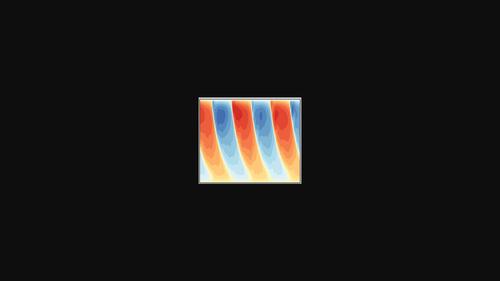当前位置:
X-MOL 学术
›
Q. J. R. Meteorol. Soc.
›
论文详情
Our official English website, www.x-mol.net, welcomes your feedback! (Note: you will need to create a separate account there.)
The graft‐versus‐host problem for data‐driven gravity‐wave parameterizations in a one‐dimensional quasibiennial oscillation model
Quarterly Journal of the Royal Meteorological Society ( IF 8.9 ) Pub Date : 2024-03-26 , DOI: 10.1002/qj.4707 Ofer Shamir 1 , David S. Connelly 1 , Steven C. Hardiman 2 , Zihan Shao 1 , L. Minah Yang 1 , Edwin P. Gerber 1
Quarterly Journal of the Royal Meteorological Society ( IF 8.9 ) Pub Date : 2024-03-26 , DOI: 10.1002/qj.4707 Ofer Shamir 1 , David S. Connelly 1 , Steven C. Hardiman 2 , Zihan Shao 1 , L. Minah Yang 1 , Edwin P. Gerber 1
Affiliation

|
Two key challenges in the development of data‐driven gravity‐wave parameterizations are generalization, how to ensure that a data‐driven scheme trained on the present‐day climate will continue to work in a new climate regime, and calibration, how to account for biases in the “host” climate model. Both problems depend fundamentally on the response to out‐of‐sample inputs compared with the training dataset, and are often conflicting. The ability to generalize to new climate regimes often goes hand in hand with sensitivity to model biases. To probe these challenges, we employ a one‐dimensional (1D) quasibiennial oscillation (QBO) model with a stochastic source term that represents convectively generated gravity waves in the Tropics with randomly varying strengths and spectra. We employ an array of machine‐learning models consisting of a fully connected feed‐forward neural network, a dilated convolutional neural network, an encoder–decoder, a boosted forest, and a support‐vector regression model. Our results demonstrate that data‐driven schemes trained on “observations” can be critically sensitive to model biases in the wave sources. While able to emulate accurately the stochastic source term on which they were trained, all of our schemes fail to simulate fully the expected QBO period or amplitude, even with the slightest perturbation to the wave sources. The main takeaway is that some measures will always be required to ensure the proper response to climate change and to account for model biases. We examine one approach based on the ideas of optimal transport, where the wave sources in the model are first remapped to the observed one before applying the data‐driven scheme. This approach is agnostic to the data‐driven method and guarantees that the model adheres to the observational constraints, making sure the model yields the right results for the right reasons.
中文翻译:

一维准两年振荡模型中数据驱动的重力波参数化的移植物抗宿主问题
数据驱动重力波参数化开发的两个关键挑战是泛化,如何确保在当前气候下训练的数据驱动方案将继续在新的气候状况下工作,以及校准,如何解释“宿主”气候模型中的偏差。这两个问题从根本上取决于与训练数据集相比对样本外输入的响应,并且通常是相互冲突的。推广到新气候状况的能力通常与对模型偏差的敏感性密切相关。为了探讨这些挑战,我们采用一维 (1D) 准两年振荡 (QBO) 模型,该模型具有随机源项,该随机源项代表热带地区对流生成的重力波,其强度和频谱随机变化。我们采用了一系列机器学习模型,包括完全连接的前馈神经网络、扩张卷积神经网络、编码器-解码器、增强森林和支持向量回归模型。我们的结果表明,基于“观测”训练的数据驱动方案可能对波源中的模型偏差非常敏感。虽然能够准确地模拟它们所训练的随机源项,但我们所有的方案都无法完全模拟预期的 QBO 周期或幅度,即使对波源有最轻微的扰动。主要的结论是,总是需要采取一些措施来确保对气候变化做出适当的反应并考虑模型偏差。我们研究了一种基于最佳传输思想的方法,其中在应用数据驱动方案之前,首先将模型中的波源重新映射到观测到的波源。这种方法与数据驱动方法无关,并保证模型遵守观察约束,确保模型因正确的原因产生正确的结果。
更新日期:2024-03-26
中文翻译:

一维准两年振荡模型中数据驱动的重力波参数化的移植物抗宿主问题
数据驱动重力波参数化开发的两个关键挑战是泛化,如何确保在当前气候下训练的数据驱动方案将继续在新的气候状况下工作,以及校准,如何解释“宿主”气候模型中的偏差。这两个问题从根本上取决于与训练数据集相比对样本外输入的响应,并且通常是相互冲突的。推广到新气候状况的能力通常与对模型偏差的敏感性密切相关。为了探讨这些挑战,我们采用一维 (1D) 准两年振荡 (QBO) 模型,该模型具有随机源项,该随机源项代表热带地区对流生成的重力波,其强度和频谱随机变化。我们采用了一系列机器学习模型,包括完全连接的前馈神经网络、扩张卷积神经网络、编码器-解码器、增强森林和支持向量回归模型。我们的结果表明,基于“观测”训练的数据驱动方案可能对波源中的模型偏差非常敏感。虽然能够准确地模拟它们所训练的随机源项,但我们所有的方案都无法完全模拟预期的 QBO 周期或幅度,即使对波源有最轻微的扰动。主要的结论是,总是需要采取一些措施来确保对气候变化做出适当的反应并考虑模型偏差。我们研究了一种基于最佳传输思想的方法,其中在应用数据驱动方案之前,首先将模型中的波源重新映射到观测到的波源。这种方法与数据驱动方法无关,并保证模型遵守观察约束,确保模型因正确的原因产生正确的结果。



























 京公网安备 11010802027423号
京公网安备 11010802027423号